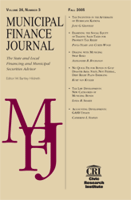Complete Issues: Volume 41 Numbers 2 and 3 (Published February 2021)
Author: James Conant.; Bill Simonsen.
Source: Volume 41, Number 03, Fall 2020 , pp.1-130(130)

< previous article |return to table of contents
Abstract:
This combined double-issue (Volume 41 Number 2 and Volume 41 Number 3) of Municipal Finance Journal is a symposium on state fiscal responses to the COVID-19 induced economic recession. It includes ten case studies that examine the early fiscal implications of COVID-19. The papers in this symposium are shorter than usual to allow for an increased number of states and for focused, yet thorough, analyses. The case studies span geography from the Pacific Northwest to the Deep South and from the Southwest to the Northeast and include the largest states in the union. The symposium includes studies of California, Connecticut, Florida, Georgia, Illinois, Massachusetts, New York, Texas, Virginia, and Washington. While each state present unique circumstances, some common themes emerge from the papers. 1. The “Salad Days” Are Over. The time before the COVID-19 induced recession in early 2020 were the “salad days,” to borrow a phrase from Robert Bifulco and Minchin Lewis’s symposium paper on New York. In all of the states covered in the symposium, with the possible exception of Illinois, times were good. The economy had experienced a sustained recovery since the Great Recession of 2008/2009 and state treasuries had benefited. The COVID-19 recession changed the fiscal outlook in the states dramatically. 2. The Recession’s Impact Is Substantial. The COVID-19 pandemic created twin crises: a health crisis first, which then led to a substantial economic slowdown. Although the impact of the pandemic was more or less pronounced in different states, all states discussed in the symposium appear to be experiencing the fiscal effects of a more than moderate recession, including reduced revenues and increased costs. However, most of the states had fiscal options, because many of them had prepared for a possible downturn by strengthening budget reserves and making other structural changes based on the lessons learned from the Great Recession. In Illinois’s case, however, COVID-19 made a bad fiscal situation even worse, because one more ratings downgrade will place the state’s debt in junk bond status. The salad days are over for all of the states despite wide variations in tax and revenue systems and spending preferences. 3. The Modal Response Is “Wait And See.” Most of the states in our symposium seem to have adopted a wait and see strategy for their current fiscal year. This is a rational response given the uncertainty surrounding both the continuing fiscal implications of COVID-19 and the possibility of increased federal aid that might be forthcoming after the election in November. For example, New York took the unprecedented action of empowering the budget director to reduce aid to local governments as needed to balance the budget if the legislature does not take action (Bifulco and Lewis, 2020). According to Bifulco and Lewis, as of this writing, these cuts would result in a 19% reduction in aid to counties, cities, towns, and school districts and would likely hit hardest the poorest school districts with higher percentages of non-white students. The most notable exception to the “wait and see” approach is Georgia, which in keeping with its fiscally conservative culture, balanced the projected budget largely through spending reductions. One implication of the “wait and see” approach is that if additional spending reductions or cuts are needed (if, say, more federal aid is not forthcoming), the longer states wait, the more severe the actions will need to be. For example, take the following hypothetical situation: suppose a certain number of furlough days would provide $100 million of relief if implemented at the beginning of the fiscal year. If the furlough days are implemented halfway through the fiscal year, twice as many days will be necessary to reduce spending by $100 million, all else equal. 4. The Worst Might Be to Come. One common element across the case studies is the projected worsening of future fiscal positions. States have various fiscal years and some (such as Connecticut and Texas) are in the middle of a biennium budget. However, outyear projections across the states indicate likely worse fiscal conditions, and at the same time, there is deep uncertainty about the length and depth of the current recession and possible federal aid. In some states, decisions made to deal with the current deficit, such as Connecticut’s plan to use most of its budget reserve, will make solving future deficits harder after that reserve is depleted. The papers in this symposium tell a nuanced and detailed story of COVID-19’s impact on ten states. This story is still unfolding, as is the story of the COVID-19 virus. The authors describe conditions at this moment in time, which may change by state or even by region if the COVID-19 virus continues to move in waves across the United States. The papers in the symposium provide important insights into how these states responded to substantial COVID-19 related fiscal challenges as reported through September 2020. We hope that you will find the discussions as interesting and informative as we have.Keywords: Keywords: COVID-19 Impact on Budgets; California Budget; Connecticut Budget; Florida Budget; Georgia Budget; Illinois Budget; Massachusetts Budget; New York Budget; Texas Budget; Virginia Budget; Washington Budget
Affiliations:
1: (Guest Editor) George Mason University; 2: (Guest Editor) University of Connecticut.